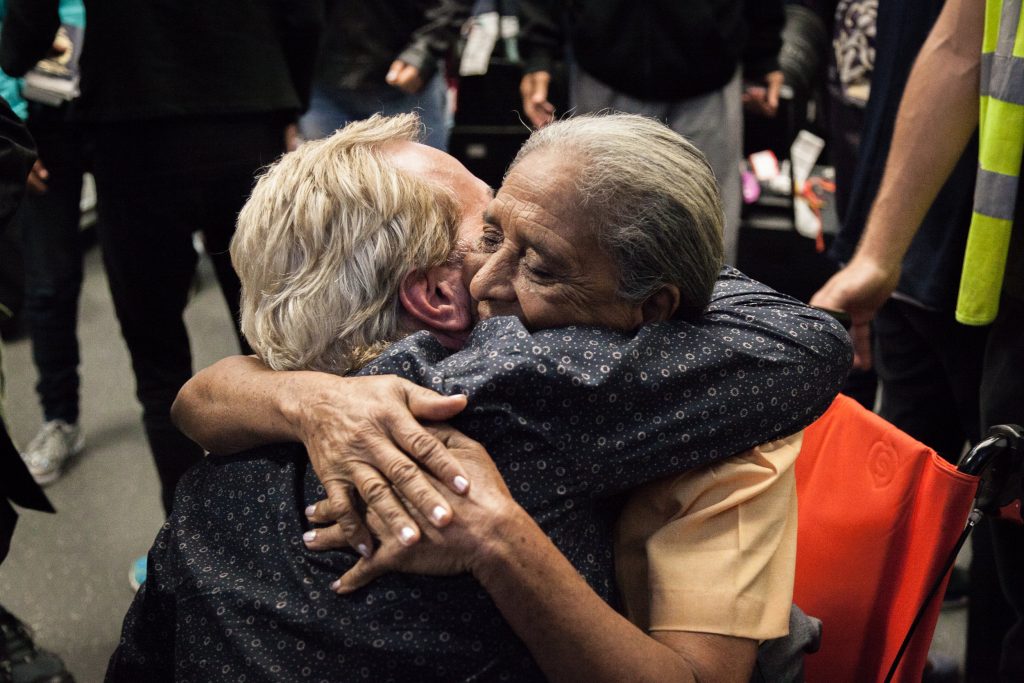“Dancing at the Vatican,” a 38-minute documentary directed by Brian Moore and produced by Amanda Spencer, showcases the plight of those suffering from Huntington’s disease (HD), a progressive neurological disorder. A parent with HD has a 50/50 chance of passing it on to his or her offspring.
The film is narrated by Emmy award-winning former NBC-TV foreign correspondent Charles Sabine, an asymptomatic HD carrier whose two beautiful young daughters accompany him to Rome.
HD causes progressive degeneration of nerve cells in the brain. Its symptoms include uncontrolled movements (the accompanying jerking and twitching is known as chorea), emotional problems, and loss of cognition. The disorder is genetic and it is fatal.
HD can strike anyone and anywhere: Folk singer Woody Guthrie purportedly died of it. But in an even crueler twist of fate, it concentrates in certain places around the globe, and they are mostly poor.
Barranquitas, Venezuela, in the Lake Maracaibo region, is one such place. Chile and Peru also have dense clusters of HD. Dilia Oviedo Guillén, from a village in Colombia, watched her husband and five children die of the disease. She now devotes her life, 24 hours a day, to nursing four more adult children who suffer from HD.
The muscular degeneration means that patients eventually lose even the use of their hands. Thus she lovingly bathes, dresses, and spoons food into their mouths as they lie in bed.
Fifteen-year-old Brenda lives in a suburb of Buenos Aires and suffers from juvenile HD, which progresses faster than the more common adult onset (in which symptoms generally begin in the patients’ 30s or 40s). The mother wasn’t up to providing the care Brenda needed so her aunt, Norma Lara, stepped up to the plate. “What else would I have done?” is her basic approach.
Villagers often erroneously believe HD to be contagious, and shun sufferers and their families as if they were leprous. Children who don’t have the disease themselves but come from an HD family are often bullied at school.
Resources are scant in Latin America, but for a precious few, HD is a passion. Ignacio “Nacho” Muñoz-Sanjuan, a neuroscientist who, along with Dr. Claudia Perandones, founded Factor-H, a charity that helps HD sufferers in Latin America; and Elena Cattaneo, HD geneticist, a professor at the University of Milan, and lifetime senator in her native Italy.
Together with those they care for, and other HD activists, a few years ago they hatched a scheme to appeal to the Vatican.
Thus the biggest event in the history of HD was launched: “Pope Francis’ Special Audience with the Huntington’s Disease Community in Solidarity with South America.”
The process was arduous, with reams of red tape and the always precarious health of the HD patients threatening to derail the plan.
The courageous transcontinental journey was undertaken by many who had never left their village, never mind their country. Some lacked even a birth certificate. But on May 18, 2017, 1,700 scientists, patients, doctors, caretakers, family, and friends converged upon the Vatican.
Brenda was chosen as a representative of all HD families to present a plaque to Pope Francis, the first Latin American ever to hold the office, and a clear crowd favorite.
The pope read a statement acknowledging the stigma, isolation, and abandonment of HD. Then he added, “Occulta nunca mas!” (“Hide no more.”). He was the first global leader ever to utter the words “Huntington’s disease.”
The film is worth watching alone for the ardor with which the children approach and embrace him, clutching his white-clad form for dear life with tears in their eyes.
Anyervi Prieto, whose father suffers from the disease, got a football signed by Brazilian soccer great Neymar Junior. Brenda got to meet and hold hands with her idol, Argentine romantic pop star Axel.
Against all Vatican protocol, Sabine led a little dance on the stage from which the pope had just departed, while the Swiss guard, as he put it, “have kittens.”
The film hopes to raise awareness about HD and the desperate plight of many HD families in Latin America.
To that end, my one complaint was that the film was too short.
I would love to have heard more from Guillén, clearly a living saint, for example, about the faith that sustains her. “They’re my children,” she said of the four with HD she cares for, “so I feel as if I have their illness.” Or from Lara, Brenda’s caretaker, who has nursed three generations of her family through HD.
I would love to have asked some of the parents with HD about the source of the trust and hope that allows them to bring children into the world, knowing that the children may suffer from the disease, too.
I can’t remotely presume to know, but in one of the many short videos available on the “Dancing at the Vatican” website, Lara says, “My thinking is that you have to give them a lot of love and support, I don’t know if that’s the right answer. … The family needs to be very close and to love that person a lot.”
And after watching this lovely film, I did think of Matthew 11:25: “I give praise to you, Father, Lord of heaven and earth, for although you have hidden these things from the wise and the learned you have revealed them to the childlike.”

